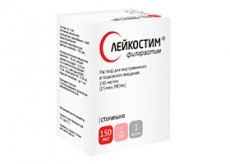Medical expert of the article
New publications
Preparations
Leucostim
Last reviewed: 04.07.2025

All iLive content is medically reviewed or fact checked to ensure as much factual accuracy as possible.
We have strict sourcing guidelines and only link to reputable media sites, academic research institutions and, whenever possible, medically peer reviewed studies. Note that the numbers in parentheses ([1], [2], etc.) are clickable links to these studies.
If you feel that any of our content is inaccurate, out-of-date, or otherwise questionable, please select it and press Ctrl + Enter.

Indications Leukostimma
It is used for the following disorders:
- neutropenia in people undergoing chemotherapy;
- potentiation of the release of stem cells into the blood of individuals undergoing chemotherapy;
- severe form of neutropenia (has a periodic, congenital or malignant nature);
- neutropenia in HIV patients;
- potentiation of the excretion of stem cells into the blood (carried out for healthy donors).
Release form
The drug is produced in the form of a liquid for subcutaneous and intravenous injections, in syringes equipped with sealed needles, having a volume of 150, 300 or 600 mcg/ml.
Pharmacodynamics
The drug is a bioactive non-glycosylated protein of a highly purified nature, regulating the proliferation and differentiation of neutrophils, and along with this, their removal into the blood from the bone marrow. It leads to an increase in the number of neutrophils, affecting their precursor cells.
The therapeutic effect develops within 24 hours, but with reduced stem cell counts in the patient (due to intensive radiation or chemotherapy), the degree of increase in the number of neutrophils may be less pronounced. It also demonstrates immunomodulatory activity.
Pharmacokinetics
With subcutaneous application, blood Cmax values are recorded after 8-16 hours. These values are proportional to the dosage used; blood neutrophil values depend on the drug level.
The half-life is 3.5-4 hours. Metabolic processes lead to the formation of peptides; only 1% of the applied portion is excreted unchanged in the urine.
Long-term administration of the drug (up to 28 days) does not cause accumulation of the substance.
 [ 3 ]
[ 3 ]
Dosing and administration
The substance can be administered intravenously or subcutaneously. The doctor selects the method of application and the dosage, which is determined by the clinical picture. Subcutaneous administration is considered more preferable. In the case of intravenous injection, the substance from the syringe must be added to a vial with 5% dextrose, after which it is administered over half an hour.
Leukostim should be used at least 24 hours after completion of chemotherapy. Use in a dose of 5-12 mcg/kg daily, 1 time per day. Therapy is carried out until normal neutrophil levels are achieved. It often lasts 2 weeks.
During therapy, the white blood cell count should be constantly monitored. If the level exceeds 50,000/mcl, the drug should be discontinued.
Treatment may cause thrombocytopenia. If platelet counts remain below 100,000/µl during repeated tests, consider temporarily discontinuing the medication or reducing its dosage.
Use Leukostimma during pregnancy
There are no adequate tests for the use of Leukostim during pregnancy; there are reports in the medical literature that filgrastim can cross the placenta. The drug should be used only in situations where the benefit is more likely to outweigh the risk of adverse effects on the fetus.
There is no comprehensive information on whether filgrastim is excreted in human milk. This possibility cannot be excluded, therefore the drug should be prescribed to breastfeeding women with extreme caution.
Contraindications
Side effects Leukostimma
Main side effects:
- pain sensations developing in the area of bones and muscles;
- hepato- or splenomegaly;
- symptoms of dysuria;
- temporary decrease in blood pressure;
- feeling tired or weak, as well as headaches;
- increased uric acid and alkaline phosphatase levels;
- alopecia;
- signs of allergy (usually associated with intravenous injections at the initial stage of therapy).
Interactions with other drugs
Because myeloid cells in the active growth stage are extremely sensitive to cytostatics, filgrastim must be used 24 hours before or after the administration of these medications.
The element 5-fluorouracil potentiates neutropenia.
If the drug is used to mobilize progenitor cell activity after chemotherapy, it must be taken into account that the intensity of this action is weakened by prolonged use of carmustine, melphalan or carboplatin.
It has no pharmaceutical compatibility with NaCl.
Storage conditions
Leukostim must be stored at a temperature range of 2-8°C.
 [ 16 ]
[ 16 ]
Shelf life
Leukostim can be used within a 2-year period from the date of manufacture of the therapeutic drug.
 [ 17 ]
[ 17 ]
Attention!
To simplify the perception of information, this instruction for use of the drug "Leucostim" translated and presented in a special form on the basis of the official instructions for medical use of the drug. Before use read the annotation that came directly to medicines.
Description provided for informational purposes and is not a guide to self-healing. The need for this drug, the purpose of the treatment regimen, methods and dose of the drug is determined solely by the attending physician. Self-medication is dangerous for your health.

